This site contains affiliate links. As an Amazon Associate, I earn a commission from qualifying purchases at no extra cost to you. Full Disclosure Here.
In this article, we’ll cover the top red dot magnifiers of 2025, carefully selected and ranked by a Marine. We discuss the key features that make these magnifiers stand out, including their durability, compatibility, and magnification power. Each product is reviewed in detail, highlighting its specific strengths and ideal usage scenarios to help you find the perfect magnifier for your firearm needs, balancing performance and value.
A red dot sight is one of the best upgrades you can make to a close-range firearm but there are some serious drawbacks, especially if that red dot is going to find its home atop a rifle capable of being utilized at various ranges.
Red dots are really only good for about 50-100 yards and after that, you’ll want something magnifying your sight picture to ensure proper target identification and precision. No worry, you won’t need to get rid of your red dot!
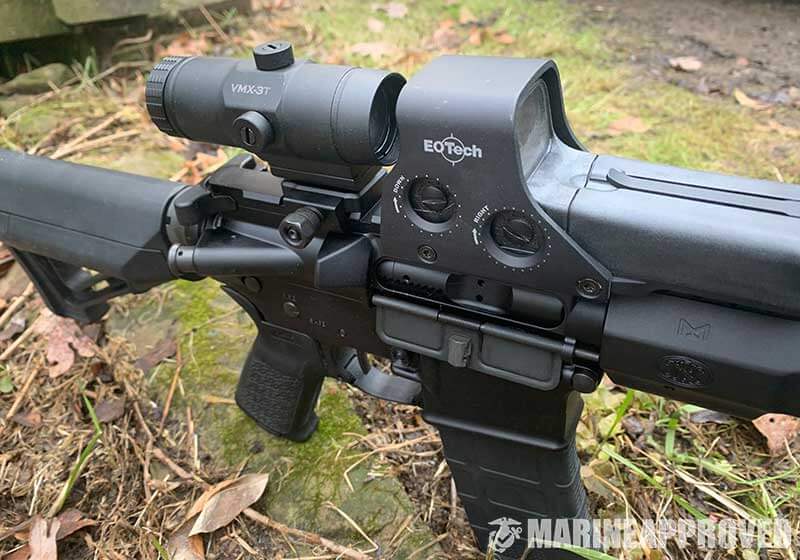
At A Glance: Our Top Picks for Red Dot Magnifiers in 2025 (AR-15s & PCCs)
- Best Overall: EOTech G33
- Best Lightweight (Titanium): Holosun HM3XT (Titanium)
- Best Under $400: Vortex Micro 3X
- Best 4× Option: SIG Sauer Juliet4
- Best Micro Footprint: Primary Arms SLx 3X Gen IV Micro
You can simply add a magnifier that works in tandem with your red dot, giving you the option to cycle between that precious 1x up close and personal red dot and also giving you magnification for when you need to engage outside of what a red dot is capable of!
In this guide, we’ll go over what red dot magnifiers do, how to find the best red dot magnifiers on the market, and how they pair up with your red dots. If you don’t already have a red dot, you can check out the Marine Approved Red Dot Sights Guide here. If you do, dive into this guide, and at the end, you’ll have all the information needed to find a good partner magnifier and I’ll do the digging for you to find the best deals!
Red Dot Magnifier Buying Guide 2025
We explore key factors in selecting a red dot magnifier in our buying guide. It’s compatibility with firearms, understanding magnifier power, evaluating lens size, assessing glass coatings, and determining durability and waterproofing. It also helps you in choosing a magnifier that balances performance and practicality according to their specific needs.
If you already know all about magnifiers, go ahead and skip this section and go straight to the reviews!
What is a Red Dot Magnifier and Why Should You Spend Your Money on One in 2025?
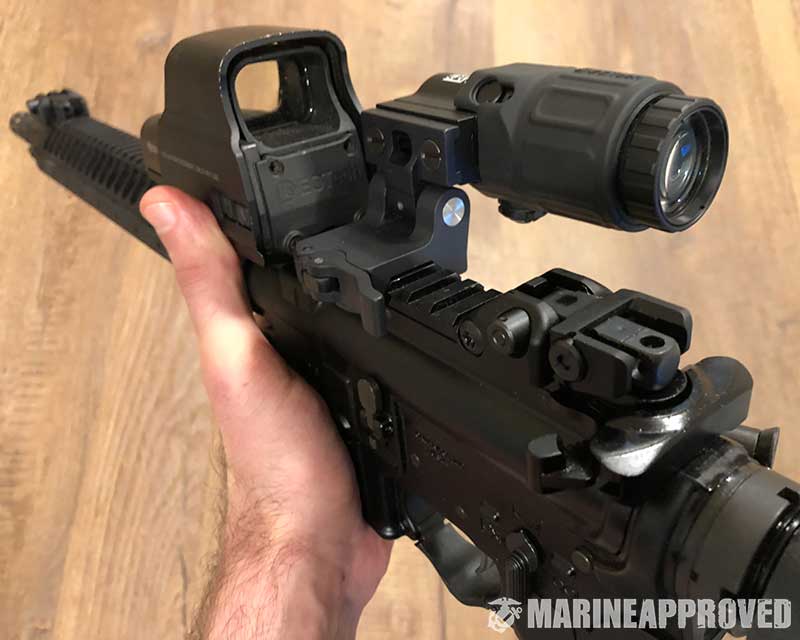
A magnifier is typically used in what’s called “Co-Witness” with a red dot or other low magnification optics where both of the optical systems are mounted on your firearm and can be used either without the magnifier in a flipped out position or with the red dot being magnified by the magnifier by simply flipping and locking into place the magnifier.
The main reason people like these is simple, it gives you the ultimate versatility in switching your weapons system capabilities from being optimized for short-range and/or close quarter combat (CQR) situations to mid-range engagements by simply reaching up and sliding over the magnifier.
Combat and combat training aren’t always going to provide you a consistent engagement range, meaning your weapons system needs to be ready for a number of different ranges and thus, a secondary optical magnifier is one of the best methods of achieving optimum close range and mid-range capabilities without switching the firearm to something else.
This means as you engage targets, say inside a building or dense jungle setting, you can use your red dot for its advantages, such as its unlimited eye relief, ultra-wide field of view, and unbeatable target acquisition speed, and then when you exit the building or come into a clearing in the woods where targets are more than just a few feet from you, you can quickly slide the magnifier over, giving you access to a magnified sight picture for taking mid to long-range shots.
Attributes to Look For
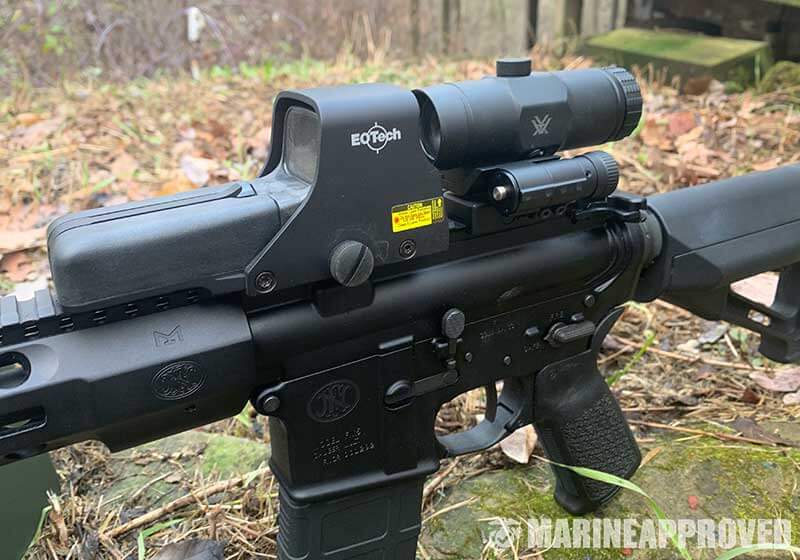
Buying a magnifier to use in co-witness with another optical system means you’re adding another entity to the marriage between your rifle and it’s current optics. Finding optics that suit your rifle perfectly and the intended usage is already difficult enough for a beginner and adding a magnifier to the mix makes things even more complicated.
First and foremost, you must determine if the magnifier is going to be compatible with your rifle. Does your rifle have enough rail space for another mount? Do you need a special mount for your specific rifle or will most included Picatinny mounts work for you? Are you already using a spacer or riser with your current optical setup? These are all questions you’ll need to make sure you have answered before ever even beginning your search for a magnifier.
Second, does a magnifier play nicely with your current optics? Are your current optics compatible with a magnifier? Do they have special reticle or glass characteristics that don’t work well with being magnified? In most cases, a simple red dot can be magnified, but sometimes when you have something like a red dot and an MOA circle reticle, that MOA circle may get distorted or cause reflection inside the magnifier, rendering your sight picture at extremely low quality.
Some magnifiers are built specifically for a certain red dot like the EOTech G33 and its counterpart, the EOTech EXPS lineup, but are also compatible with many other red dot sights too. Always check with the manufacturer to make sure your red dot is compatible with the magnifier you want to use!
Understanding Magnifier Power and Lens Sizing
Like most other optics, when shopping around, you’re going to come across some X’s and MM’s paired up with numbers that you may not understand or know how to choose between. No worries, these are easy to learn and once you get the gist of it, knowing what these mean will help you choose the right optics for your style of shooting. This is a crucial piece of information that will likely be the determinating factor of which magnifier you buy, so please read and make sure you understand before buying an expensive magnifier!
Let’s go over a common example you may find when shopping for a red dot magnifier.
4x24mm found on the Sig Sauer Juliet4.
The first number, the 4, indicates that the magnifier will magnify your sight picture of up to 4x it’s non-magnified appearance, meaning that what you see through the Juliet4 will be 4x closer and larger than it is using the jelly bags in your head. Your red dot should be a 1X, meaning there is no magnification present.
The 24mm part is indicating that the Juliet4 has a 24mm objective lens. The objective lens is the lens facing your target, away from the shooter. A larger objective lens means the lens is more capable of using ambient light to create a detailed and bright sight picture. The larger the lens, the more light the magnifier is capable of using, and thus, as a general rule of thumb, the better the overall quality of the sight picture.
So, just buy the highest magnification possible with the largest objective lens and you’re done, right? Not so fast gunslinger, we still need to consider the negative tradeoffs here. The higher the magnification, the more sight picture will suffer, meaning that with high magnification, you need larger objective lenses.
Larger objective lenses take up more space and weigh significantly more, meaning you’ll be lugging around a heavy piece of glass sitting on top of your rifle, making your rifle more difficult to maneuver and operate, especially because it’ll become top-heavy. Larger objective lenses also reflect more light, meaning that if you’re in a covert situation, that big piece of glass on the front might just be what gives your position away to the enemy.
As with almost everything in life, a middle ground is what you likely want to go for here. In the world of magnifiers, I’d say look for magnification levels of 3x up to 7x with objective lenses of roughly 15mm to 28mm. Magnifiers with higher magnification levels and massive lenses generally do not perform very well, take up too much space, are too distracting to use with a red dot, and would better suit you to simply just use a scope at that point.
Is 7x magnification not powerful enough for your use case? Opt for an actual scope then! You can check out our scopes pages on AR-15s here or 300 Blackout here.
A final note here, the red dot in your red dot sights is considered “enlarged” for target acquisition and eye relief, meaning its much larger than what a reticle would be in a highly magnified scope. When pairing a red dot with a magnifier, the magnifier is simply using the red dot and enhancing its magnification, despite the fact that the red dot reticle is optimized for 1x magnification power. Just like when you zoom in on a photo you took with a phone camera, the picture gets highly distorted and blurry. Magnification levels that are too drastic will actually result in that red dot crowding out the sight picture entirely, making the duo pretty much useless!
Glass Coatings Explained
Yup, just like any other scope, your lenses will likely be coated with a bunch of goodies that on a magnifier, are both important to have, but also important to work together with what’s on the original unmagnified optical system you’re using. The better and more present the coatings are, the more expensive the magnifier will be!
Coatings on lenses do a bunch of different things so it’s important to consider what coatings are present on the glass of the magnifier you’re going to buy and the red dot you’re using.
Some examples of what coatings do are added protection against abrasion, water-repelling, anti-reflection, high fidelity coatings that help to enhance sight picture, coatings to help with light transmission, and many other coatings.
Most of these coatings end up being named crazy things because a lot of them are developed by the manufacturer of the magnifier itself, meaning they’re proprietary and comparing them through the written word is incredibly difficult. Unfortunately, there are no standards for naming coatings. Something named Ultra HD glass coating may not perform the same as High Fidelity coating even though both of them have the same goal of raising the quality of the sight picture.
In other words, not all coatings are created equally and some manufacturers, like Sig Sauer, Trijicon, Aimpoint, and Vortex Optics have their own proprietary coatings that are of high quality but are only used on their specific product lines, making them difficult to compare unless you actually have them side by side to see the differences.
Durability Considerations

These magnifiers are going to be hanging off of your rifle at roughly a 45-degree angle when not in use which means it’ll be easy to bump them on things and expose them to the elements.
Waterproofing is pretty much a standard attribute for me when considering optics. I operate firearms whether its rain or shine and for me, good waterproofing is of the utmost importance, so much so that I refuse to buy magnifiers that aren’t waterproof. Red dot magnifiers with good resistance to water will be gas purged, usually with Nitrogen or Argon, and will be sealed with a special O-ring ensuring that the inside stays filled with those gases and the outside doesn’t allow water to seep in.
Waterproofing is more important than just water ruining your optics, though, as generally waterproof optics are also far better in terms of being resistant to fogging up as well. Many waterproof optics will also have water-repelling coatings on the lenses but I have found some that lack this, which is kind of silly, so make sure they have both!
I think all of the red dot magnifiers I’ll ever recommend are constructed with either an aluminum or steel casing. The outside of the magnifier must be strong and resist impact from your rifle falling to the ground or whatever else crazy stuff happens.
If the shell isn’t strong, your optics could easily become damaged and render your magnifier useless. Most of the time, you’ll find high-quality magnifiers that are built out of T6 aluminum, which is the same stuff made to construct airplanes. T6 Aluminum has a bunch of characteristics like being decently resistant to corrosion, being lightweight, and being extremely durable without weighing too much. In many cases, high-quality optics manufacturers will also coat the shell in some type of rubberized armor to further increase its durability.
As a final note here, make sure the mount your magnifier is placed on is strong and durable. Many of these magnifiers will use a swing mount, meaning the optics will ride on a pivot point. These pivot points are prone to failure when they aren’t of high quality and many of the mounts that magnifiers come with are built as the bare minimum for them to work out of the box. I almost always recommend getting a trusted third party mount, like the Larue Tactical QD Pivot Mount for Aimpoints magnifiers found here.
Of course, you’ll need to ensure the mount you buy fits your optics, is a pivot mount, has a locking mechanism that works for you, and fits your rifle’s rail space! Steel mounts are the way to go, so if your optics come with a plastic mount, I’d order a steel mount to replace it with as soon as possible.
Speaking of mounts, you could also choose to utilize a mount with a quick-release system. These allow the magnifier to be removed quickly when you know for sure you won’t need it, like if you’re usually operating in areas that would warrant both CQB and mid-range optics but you’re suddenly positioned at a CQB situation for a long duration of time. Another good reason to use a quick-release mount would be in the case that your flip mount becomes damaged and cannot flip out of the way of your red dot or the magnifier itself becomes incapacitated in some manner.
Lastly, you may need your rifle to hug a surface or shoot from a position that doesn’t allow for the magnifier to hang off the side of your rifle, like if you’re shooting through a hole in a wall or something such as that. Those pesky 45-degree magnifiers can sometimes just be in the way and all you want to do is rip it off!
6 Best Red Dot Magnifiers in 2025
Whether you’re stretching your rifle’s legs at the range or chasing better target ID in the field, a good magnifier can turn your basic red dot setup into a flexible mid-range optic. Below are our top picks from trusted brands like EOTech, Sig Sauer, and Vortex—companies that have earned their reputations for building durable, crystal-clear glass that helps shooters reach out with confidence. If you spot a new model worth testing, drop it in the comments and we’ll get our hands on it.
| Image / Badge | Product | Buy |
|---|---|---|
|
Best Overall

|
EOTech G33
|
VIEW ON AMAZON → VIEW ON OPTICS PLANET → |
|
Best Lightweight (Titanium)
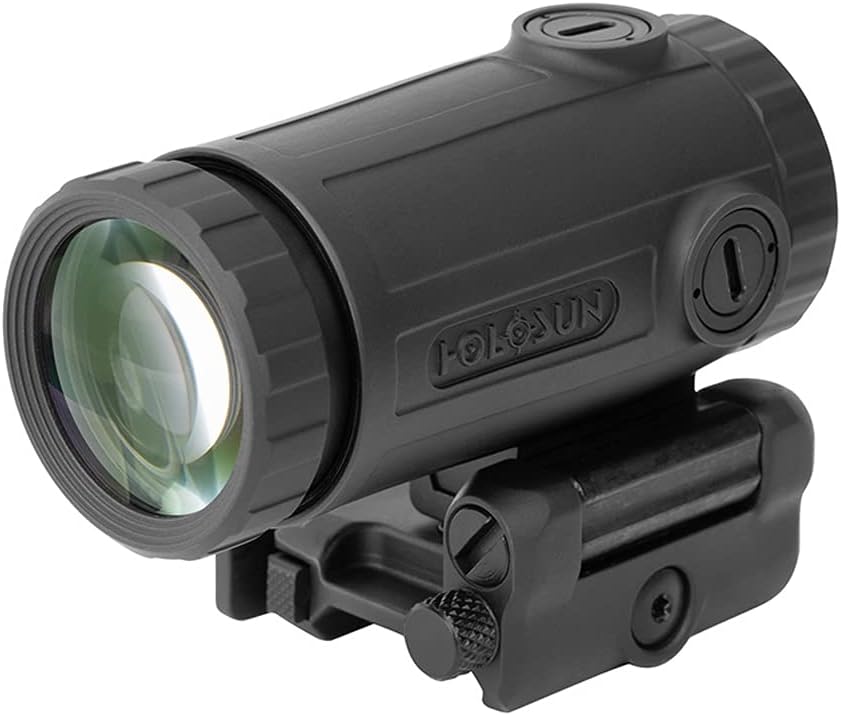
|
Holosun HM3XT (Titanium)
|
VIEW ON AMAZON → VIEW ON OPTICS PLANET → |
|
Best Under $400

|
Vortex Micro 3X
|
VIEW ON AMAZON → VIEW ON OPTICS PLANET → |
|
Best 4× Option

|
SIG Sauer Juliet4
|
VIEW ON AMAZON → VIEW ON OPTICS PLANET → |
|
Best Micro Footprint
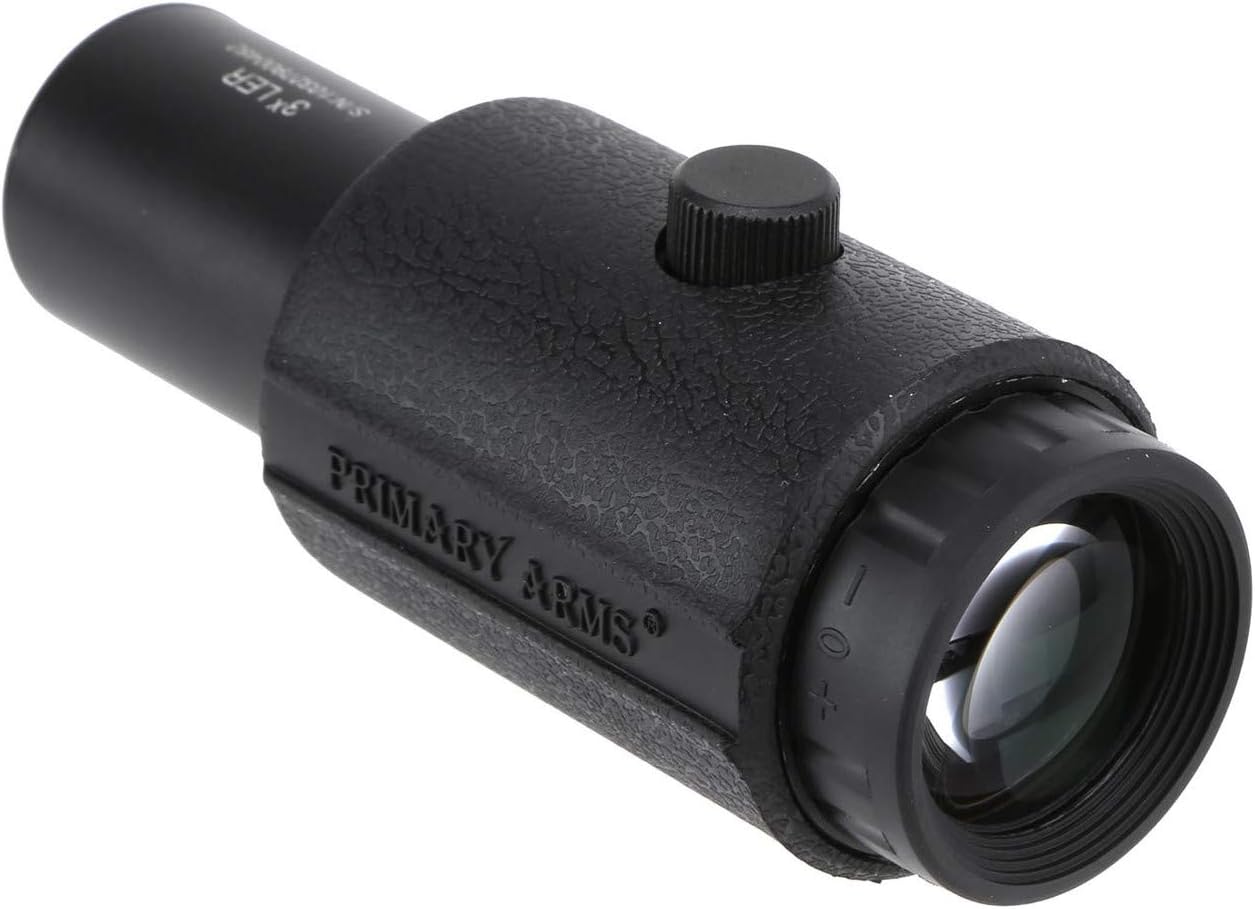
|
Primary Arms SLx 3X Gen IV Micro
|
VIEW ON AMAZON → VIEW MOUNT OPTION → |
1. Aimpoint 3X-C Magnifier

Optical Specs: 3× fixed magnification with a 20 mm objective lens and diopter adjustment range of -2 to +2.
Construction: Machined aluminum tube with matte black anodized finish and shock-absorbing rubber armor.
Eye Relief: 56 mm (≈ 2.2 in).
Waterproof Rating: Submersible to 1 m (3 ft).
Weight: ≈ 7.8 oz (222 g).
Compatibility: Pairs with Aimpoint PRO, Comp M5, Micro T-2, and other red dots using a flip-to-side mount (not included).
My Review: Aimpoint has long been the standard for duty-grade optics, and the 3X-C carries that pedigree into their civilian line. You get the same Swedish glass clarity and ruggedness as the mil-spec units but in a more affordable package. The optical quality is excellent — clear edge to edge with no visible color shift — and the eye relief is more forgiving than most older magnifiers. The rubber armor makes it feel like it could bounce off a doorframe without losing zero. If you run an Aimpoint red dot already, this is the logical partner for medium-range precision or target ID past 100 yards.
Unlike many budget 3× options, the 3X-C is also night-vision compatible — a small but important detail for hunters and professional users. The glass uses Aimpoint’s anti-reflection coatings that keep glint to a minimum, and it handles recoil from 5.56 and .308 rifles without issue. The only catch is that it ships without a mount, so budget for Aimpoint’s twist-mount or any quality flip-to-side option of your choice.
Compared To: The 3X-C sits just below the mil-issued 3XMag-1 in Aimpoint’s lineup. You get the same optical performance at a lower price by skipping the quick-detach mount and a bit of submersion depth (3 ft vs 80 ft). For civilian and training use, it’s the smarter buy.
Pros
- True Aimpoint clarity and NV compatibility at a lower price point
- Durable rubber-armored body soaks up impact and abuse
- Excellent light transmission and edge-to-edge sharpness
- Fully sealed and nitrogen-purged for fog and water resistance
- Compatible with a wide range of flip mounts and red dots
Cons
- No mount included out of the box
- Heavier than newer micro magnifiers (Vortex Micro 3X, HM3XT)
- Limited 3 ft waterproof depth vs Aimpoint’s duty models
- Price still premium compared to budget alternatives
2. EOTech G33 Magnifier

Optical Specs: 3× magnification, 25 mm objective lens, adjustable diopter, and fully multi-coated glass for high light transmission.
Construction: Aluminum housing with hard-anodized matte finish and integrated shock-absorbing rubber armor.
Eye Relief: 2.2 in (55 mm).
Field of View: 7.3° (37 ft @ 100 yds).
Weight: 11.2 oz (317 g).
Waterproof Rating: Submersible to 33 ft (10 m).
Mount: Quick-Detach lever mount with Switch-to-Side (STS) flip mechanism.
Compatibility: Optimized for EOTech EXPS and 518 series HWS units but also pairs well with most red dots at the same mount height.
My Review: The EOTech G33 has been the gold standard for flip-to-side magnifiers for over a decade — and for good reason. The glass is crystal clear, the 3× magnification is perfect for mid-range shooting, and the STS mount is still the smoothest transition system I’ve used. Flick it to the side and it locks cleanly out of view without wobble; flip it back in line and you’re instantly zoomed in. EOTech also nailed the diopter adjustment — focus snaps cleanly and stays put after a day of hard use.
Built for professional use, the G33 is fully fog-proof, shock-resistant, and night-vision compatible. EOTech’s coatings keep reflections down and colors true under white light or NVGs. If you already run an EXPS or 518 HWS, this is the magnifier you want behind it. It’s not cheap, but it’s also the last magnifier most people ever buy.
Compared To: The G33 is smaller and lighter than the older G23 and the newer G45 (5× version). If you need more reach, the G45 is solid, but for balanced size, weight, and clarity, the G33 remains the sweet spot.
| Model | Magnifier Only (G33) | HHS I (G33 + EXPS3-4) | HHS II (G33 + EXPS2-2) | HHS III (G33 + 518.2) |
|---|---|---|---|---|
| Night Vision Capability | Yes | Yes | No | No |
| Weight | 11.2 oz | 22.4 oz | 22.4 oz | 25 oz |
| Water Resistance | 33 ft | 33 ft | 10 ft | 10 ft |
| Side Button Operation | N/A | Yes | Yes | Yes |
| Mount Type | 1″ Weaver QD Lever (STS) | 1″ Weaver QD Lever | 1″ Weaver QD Lever | 1″ Weaver QD Lever |
Pros
- Battle-proven durability and NV compatibility
- Best-in-class Switch-to-Side mount — fast, solid, ambidextrous
- Sharp glass and accurate color transmission
- Holds zero and alignment through heavy recoil
- Perfect fit with EOTech EXPS and 518 series HWS
Cons
- Heavier than new micro magnifiers (Vortex Micro 3X, HM3XT)
- Price premium reflects professional use heritage
- Mount adds height — check your co-witness setup before buying
3. SIG Sauer Juliet4 Magnifier

Check Price on Amazon | Buy on OpticsPlanet
Optical Specs: 4× magnification, 24mm objective lens, fully multi-coated dielectric prism with HDX (High Definition + High Transmittance) glass.
Eye Relief: 2.5 in (63.5 mm).
Field of View: 6.25° (32.5 ft @ 100 yds).
Length: 4.2 in (107 mm).
Weight: 12.5 oz (354 g).
Waterproof Rating: IPX8 (submersible up to 20 meters).
Housing: CNC-machined aircraft-grade aluminum.
Mount: PowerCam 90° flip-to-side mount with quick-release lever and height spacers (1.41″, 1.53″, 1.63″).
Compatibility: Works perfectly with the SIG Sauer ROMEO red dot series or any similar 1.41″–1.63″ sight height.
My Review: SIG Sauer’s Juliet4 delivers the ideal middle ground between optical power and field efficiency. It provides 4× magnification in a compact, rugged body that’s lighter and shorter than you’d expect. The proprietary Electro-Optic System integrates dielectric prism coatings with SIG’s signature HDX glass, giving you near-perfect color fidelity and crisp edge-to-edge clarity — even in low light. The LensShield coating keeps dust, oil, and water off the glass so you’re not constantly wiping it down in the field.
The PowerCam 90° mount is a highlight — it’s a quick-flip system that feels more refined than most competitors, letting you move seamlessly from close-quarters to 400+ yard shots without breaking cheek weld. It also locks solidly in both positions, avoiding the “wobble” cheaper mounts suffer from. Combined with its IPX8 waterproofing and integrated lens caps, this magnifier feels built for real-world abuse, not range toys.
Compared To: The Juliet4 offers more reach than the Juliet3 (3×) while maintaining nearly the same footprint. It’s also sharper and has better coatings. Shooters running SIG’s Romeo 4H or Romeo 5 red dots will find the alignment spot-on, but it works great behind Holosun or EOTech setups as well.
Pros
- Outstanding HDX glass clarity and dielectric prism design
- Includes PowerCam 90° quick-flip mount with QD lever
- Adjustable height spacers for perfect co-witness setup
- Rugged CNC aluminum housing, IPX8 waterproof
- Compatible with most red dot optics (especially SIG Romeo series)
Cons
- Flip-to-side hinge can feel stiff until broken in
- 4× magnification slightly narrows FOV for fast transitions
- Heavier than micro magnifiers like the Vortex Micro3X or HM3XT
4. Vortex Micro 3X Magnifier

Optical Specs: 3× magnification, 22 mm objective lens, fully multi-coated glass with anti-reflective coatings for high light transmission.
Eye Relief: 2.64 in (67 mm).
Field of View: 38.2 ft @ 100 yds.
Weight: 6.9 oz (optic only), 9.55 oz with mount.
Mount: Quick-release flip-to-side with patented camlock system — adjustable for right- or left-hand use.
Co-Witness Options: Absolute (1.41″) or Lower 1/3 (1.57″) via included riser.
Construction: Hard-anodized aluminum body, nitrogen purged, and O-ring sealed for full fog and water resistance.
Warranty: Backed by Vortex’s unconditional, lifetime VIP Warranty.
My Review: Vortex finally retired the aging VMX-3T and gave shooters something they’ve wanted for years — a smaller, lighter, sharper magnifier that doesn’t feel like a brick hanging off your rail. The Micro 3X is one of the cleanest glass-to-weight ratios in this price range. It’s bright, crisp, and genuinely compact, so it doesn’t throw off rifle balance or snag when running gear. The new flip mount is leagues better than the old screw clamp — it locks up tight, flips with one finger, and can be reversed for left-hand shooters.
Image quality is excellent. Vortex’s coatings keep colors true, and the diopter adjustment lets you dial in a razor-sharp reticle even if your eyes aren’t perfect. It holds alignment well under recoil and returns to zero after repeated flips. The field of view isn’t as wide as the Holosun HM3XT, but it’s noticeably brighter in low light. It’s the kind of optic that just works — no drama, no zero shift, no weight penalty.
Compared To: The Micro 3X essentially replaces the old VMX-3T with better glass, less weight, and far more ergonomic mounting. If you’re a Vortex fan or want a durable magnifier under $400, this is the one to buy. The only reason to upgrade would be for the Micro 6X if you need extra magnification range.
Pros
- Compact and lightweight design — great balance on AR platforms
- Bright, clear glass with accurate color and minimal distortion
- QD flip mount is secure, smooth, and reversible
- Excellent eye relief and forgiving eye box for fast transitions
- Lifetime VIP warranty and rock-solid customer support
Cons
- Field of view narrower than the Holosun HM3XT or EOTech G33
- No protective rubber armor like the Aimpoint 3X-C
- Still uses a two-piece mount — not as compact as newer micro frames
5. Holosun HM3XT (Titanium)

Optical Specs: 3× magnification, 24 mm objective lens, fully multi-coated optical glass with anti-glare treatment for maximum light transmission.
Field of View: 33.3 ft @ 100 yds.
Eye Relief: 2.75 in (70 mm).
Weight: 10.5 oz (with mount).
Housing: Grade-5 titanium chassis with IP67 waterproof rating and nitrogen-filled fogproof internals.
Mount: QD flip-to-side Picatinny/STANAG mount with both 1.41″ absolute and 1.63″ lower-1/3 co-witness spacers.
Adjustments: Windage and elevation screws for precise alignment.
Compatibility: Works perfectly with Holosun 510C, 512, 403, and most Aimpoint-height red dots.
Warranty: Limited Lifetime from Holosun.
My Review: Holosun’s HM3XT feels like the evolution of the classic HM3X — sleeker, stronger, and lighter without sacrificing clarity. The titanium body is no gimmick; it takes serious abuse, shrugs off salt spray, and doesn’t dent like aluminum. The optics are surprisingly sharp for the price, delivering realistic color and edge-to-edge contrast that rivals higher-priced units. The 2.75-inch eye relief is about perfect for ARs, and the new flip mount is firm but smooth — no sloppy hinge, no rattling at the range.
The transition from 1× to 3× is quick and repeatable thanks to the positive-locking cam system, and you can swap the spacer to match absolute or lower-1/3 co-witness setups. It’s smaller than it looks in photos and feels perfectly balanced behind a micro dot. For shooters who like Holosun’s multi-reticle sights (like the 510C or EPS), this magnifier matches the glass quality and build philosophy — tough, efficient, and priced right.
Compared To: The HM3XT is roughly an ounce lighter and nearly an inch shorter than the aluminum HM3X. The upgrade to titanium adds both strength and corrosion resistance, making it the clear choice for hard-use rifles or saltwater environments. If you don’t need titanium, the HM3X still delivers most of the performance at a lower cost.
Pros
- Grade-5 titanium housing — ultra-strong, corrosion-resistant, and lightweight
- Excellent optical clarity with Holosun’s multi-coated lenses
- Solid QD flip mount with both absolute and lower-1/3 co-witness spacers
- Generous eye relief and smooth magnifier transition
- Compact footprint pairs perfectly with most red dots
Cons
- Pricier than the aluminum HM3X for similar magnification
- Still limited to fixed 3× — not ideal for long-range PID work
- Titanium body can scratch more easily than anodized aluminum if unprotected
6. Primary Arms SLx 3X Gen IV Micro

Check Price on Amazon | Buy Side-Swing Mount
Optical Specs: 3× magnification, 24 mm objective lens, fully multi-coated glass with improved Gen IV coatings for color fidelity and brightness.
Eye Relief: 2.65 in (67 mm).
Field of View: 37.9 ft @ 100 yds (12.6°).
Weight: 7.3 oz (206 g).
Housing: 6061-T6 aluminum with full-length rubber armor sleeve for impact resistance.
Mount: Ships without mount – compatible with Primary Arms Side-Swing Mount or any Aimpoint-height QD flip mount.
Adjustments: Azimuth and elevation alignment for centering your red-dot reticle.
Weather Proofing: Nitrogen-purged, waterproof, and fog-resistant.
Warranty: Lifetime warranty from Primary Arms.
My Review: Primary Arms has been quietly refining their SLx magnifiers for years, and the Gen IV Micro finally nails the formula. It’s smaller, sharper, and more forgiving than any previous version. The jump in eye relief (2.65″ vs 1.8″ on older models) makes it much more comfortable for shooters running compact setups or LPVO height optics. The glass is clear with solid edge-to-edge performance, and the diopter adjustment makes fine-tuning your dot crisp and easy. It’s one of those optics that punches above its price class – nothing fancy, just good engineering done right.
The Gen IV body feels tough but light thanks to its aluminum chassis wrapped in rubber armor, which adds grip and shock protection. There’s no mount included, but honestly, that’s a plus in my book – it lets you pair it with your preferred flip-to-side QD system. I tested it with the Primary Arms Side-Swing Mount, and it held alignment perfectly behind an Aimpoint PRO and Holosun 510C. For anyone upgrading from a Gen II or III, the new optics and eye box alone make the change worthwhile.
Compared To: The SLx Gen IV Micro sits right between the Vortex Micro 3X and Holosun HM3XT in performance. It’s a little more compact than both and cheaper than the Holosun, but gives up a bit of light transmission in low-light conditions. Still, for the price, few magnifiers deliver this kind of clarity or comfort.
Pros
- Excellent clarity and long-eye-relief design
- Compact, lightweight, and durable with rubber armor
- Adjustable diopter + azimuth/elevation centering
- Affordable without feeling “budget”
- Pairs easily with most red dots and aftermarket mounts
Cons
- No mount included (out-of-box buyers will need to add one)
- Not quite as bright as premium options like the Juliet 4 or HM3XT
- Limited to fixed 3× magnification – no variable option
FAQs
Do I really need a magnifier with a red dot?
Not usually. If you shoot mostly inside 0–100 yards, a plain red dot is faster and simpler. A magnifier is useful when you want clearer target ID or some extra reach past 100–150 yards while retaining a 1× option.
Will a magnifier change my optic’s zero?
No — your zero remains on the red dot/holographic sight. If the dot appears off-center while magnified, use the magnifier’s alignment adjustments; don’t alter your optic’s zero to compensate.
What magnification should I pick — 3× or 6×?
3× is the best all-round choice: wider field of view, faster target acquisition, and lighter. Choose 6× only if you need extra reach and accept a narrower FOV and slower transitions up close.
Do magnifiers work behind EOTech and other holographic sights?
Yes — holographic sights pair especially well with magnifiers because their reticles maintain appearance under magnification. Just confirm mount height and eye relief compatibility before buying.
Which mount height is best (absolute, lower-1/3, 1.93″)?
Match the mount to your dot and typical use. Lower-1/3 (~1.57–1.63″) is the most versatile for duty and field use. Absolute (~1.41″) suits prone/bench work; taller heights suit NV or specific plate rigs but require consistent cheek weld.
How important is eye relief on a magnifier?
Very. Longer, forgiving eye relief and a good eye box let you acquire the sight picture quickly and comfortably. Micro-magnifiers with long eye relief outperform older heavy bricks in practical use.
Will magnification make my dot look fuzzy or bloomed?
It can — especially with astigmatism or excessive brightness. Reduce dot brightness and use the magnifier’s diopter to sharpen the image. Holographic sights often appear cleaner magnified than some reflex dots.
Should I choose an LPVO instead of a red dot + magnifier?
If your primary work is 300+ yards, an LPVO is usually better. For most shooters who operate inside ~200 yards and want a fast 1× plus occasional magnification, red dot + magnifier is lighter and faster to transition.
Is a QD flip-to-side mount necessary?
A reliable flip-to-side mount is strongly recommended. QD adds convenience but ensure the hinge and latch are high quality — sloppy mounts harm accuracy and feel.
Quick setup tips before you shoot with a magnifier?
Match heights, set the magnifier diopter, center the dot using the magnifier’s adjustments, and test at your normal shooting brightness. If using a circle-dot reticle, check for reflections at night.
Magnifiers bridge the gap between CQB and mid-range — giving you the reach of a scope without losing red dot speed. Whether you’re running an EOTech, Holosun, or Aimpoint, pairing it with the right magnifier can make your setup twice as capable.


Where does the Aimpoint 3X-C fall within this comparison?
Semper Fi from a fellow Devil, I really enjoyed and appreciate your list! I’ve been researching 3×’s for months now trying to decide what to go with. Eye relief is very high in my list of features because I don’t want to lose my rear BUIS. Anyway, was wondering if you, or anyone reading this, has had any experience with the X-Vision MAAG 3× magnifier? I just came across it on Sportsman’s Guide. I’ve never heard of the company before, but the magnifier runs a little over $200, has a flip mount, aluminum housing, waterproof, shock/fog proof, nitrogen purged, etc, but what got me interested was A) its size, very similar if not the same as the vortex VMT3 Micro, & B) it’s 2.5″ eye relief. Which all sounds really good and IMO is basically the same as the Vortex, but $100 or so less.
Any thoughts on this one would be great. Or any input from anyone who’s tried it yet.
Thanks.